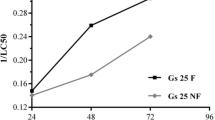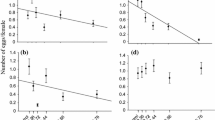Abstract
The increasing demand for biofuels favored the expansion of sugarcane and, as a consequence, in the consumption of pesticides in Brazil. Amphibians are subject to pesticide exposure for occurring in or around sugarcane fields, and for breeding at the onset of the rainy season when pesticide consumption is common. We tested the hypothesis that herbicides used in sugarcane crops, although employed for weed control and manipulated at doses recommended by the manufacturers, can cause lethal and sublethal effects on amphibian larvae. Boana pardalis was exposed to glyphosate, ametryn, 2,4-D, metribuzin and acetochlor which account to up to 2/3 of the volume of herbicides employed in sugarcane production. High mortality was observed following prolonged exposure to ametryn (76%), acetochlor (68%) and glyphosate (15%); ametryn in addition significantly reduced activity rates and slowed developmental and growth rates. AChE activity was surprisingly stimulated by glyphosate, ametryn and 2,4-D, and GST activity by ametryn and acetochlor. Some of these sublethal effects, including the decrease in activity, growth and developmental rates, may have important consequences for individual performance for extending the larval period, and hence the risk of dessication, in the temporary and semi-permanent ponds where the species develops. Future studies should seek additional realism towards a risk analysis of the environmental contamination by herbicides through experiments manipulating not only active ingredients but also commercial formulations, as well as interactions among contaminants and other environmental stressors across the entire life cycle of native amphibian species.



Similar content being viewed by others
Data availability
After publication all data are available upon request.
References
Altmann J (1974) Observational study of behaviour: sampling methods. Behaviour 49:227–267
Armas ED, Monteiro RTR, Amâncio AV, Correia RML, Guercio MA (2005) Uso de agrotóxico em cana-de-açúcar na bacia de Rio Corumbataí e o risco de poluição hídrica. Quím Nova 28:975–982
Armas ED, Monteiro RTR, Antunes PM, dos Santos MAPF, Camargo PB, Abakerly RB (2007) Diagnóstico espaço-temporal da ocorrência de herbicidas nas águas superficiais e sedimentos do rio Corumbataí e principais afluentes. Quím Nova 30:1119–1127
Bellezi L, Ilha P, Schiesari L (2015) Ontogenetic variation in the sensitivity of the gladiator frog, Hypsiboas faber, to inorganic nitrogen. Copeia 103:14–21
Bernard PA, Toyoshima E, Eccles CU, Mayer RF, Johnson KP, Max SR (1985) 2,4-Dichlorophenoxyacetic acid (2,4-D) reduces acetylcholinesterase activity in rat muscle. Exp Neurol 87:544–556
Boone MD, Cowman C, Davidson C, Hayes T, Hopkins W, Relyea R, Schiesari L, Semlitsch R (2007) Evaluating the role of environmental contamination in amphibian population declines. In: Gascon C, Collins JP, Moore RD, Church DR, McKay J, Mendelson II J (eds.) Amphibian conservation action plan. The World Conservation Union (IUCN), Gland, p 32–35
Bradford MM (1976) A rapid and sensitive method for the quantitation of microgram quantities of protein utilizing the principle of protein-dye binding. Anal Biochemy 72:248–254
CEPF (Critical Ecosystem Partnership Fund) (2020). Biodiversity hotspots defined. https://www.cepf.net/our-work/biodiversity-hotspots/hotspots-defined. Accessed 1 Feb 2020
Čolović MB, Krstić DZ, Lazarević-Pašti TD, Bondžić AM, Vasić VM (2013) Acetylcholinesterase inhibitors: pharmacology and toxicology. Curr Neuropharmacol 11:315–335
Daam MA, Moutinho MF, Espíndola ELG, Schiesari L (2019) Lethal toxicity of the herbicides acetochlor, ametryn, glyphosate and metribuzin to tropical frog larvae. Ecotoxicology 28:707–715
Damodaran TV, Jones KH, Patel AG, Abou-Donia MB (2003) Sarin (nerve agent GB)-induced differential expression of mRNA coding for the acetylcholinesterase gene in the rat central nervous system. Biochem Pharmacol 65:2041–2047
Davidson C, Shaffer HB, Jennings MR (2002) Spatial tests of the pesticide drift, habitat destruction, UV-B, and climate-change hypotheses for California amphibian declines. Conserv Biol 16:1588–1601
Ellman GL, Courtney KD, Andres Jr V, Feather-Stone RM (1961) A new and rapid colorimetric determination of acetylcholinesterase activity. Biochem Pharmacol 7:88–95
FAO (Food and Agriculture Organization of the United Nations) (2018) FAOSTAT, www.fao.org/faostat. Accessed 23 Jan 2020
Ferreira CRRPT (2000) Defensivos agrícolas: situação do mercado. Inf Econ 30:57–60
da Fonseca MB, Glusczak L, Moraes BS, de Menezes CC, Pretto A, Tierno MA, Zanella R, Gonçalves FF, Loro VL (2008) The 2,4-D herbicide effects on acetylcholinesterase activity and metabolic parameters of piava freshwater fish (Leporinus obtusidens). Ecotoxicol Environ Saf 69:416–420
Freitas JS, Girotto L, Goulart BV, Alho LOG, Gebara RC, Montagner CC, Schiesari L, Espíndola ELG (2019) Effects of 2,4-D-based herbicide (DMA® 806) on sensitivity, respiration rates, energy reserves and behavior of tadpoles. Ecotoxicol Environ Saf 182:109446
Glusczak L, Miron DS, Crestani M, Fonseca MB, Pedron FA, Duarte MF, Vieira VLP (2006) Effect of glyphosate herbicide on acetylcholinesterase activity and metabolic and hematological parameters in piava (Leporinus obtusidens). Ecotoxicol Environ Saf 65:237–241
Gosner (1960) A simplified table for staging anuran embryos and larvae with notes on identification. Herpetologica 16:183–190
Green JW, Springer TA, Holbech H (2018) Statistical analysis of ecotoxicity studies. Wiley. https://doi.org/10.1002/9781119488798
Hayes TB, Falso P, Gallipeau S, Stice M (2010) The cause of global amphibian declines: a developmental endocrinologist’s perspective. J Exp Biol 213(6):921–933
Hammer Ø, Harper DAT, Ryan PD (2001) PAST: paleontological statistics software package for education and data analysis. Palaeontol Electron 4:9
Ilha P, Schiesari L (2014) Lethal and sublethal effects of inorganic nitrogen on gladiator frog tadpoles (Hypsiboas faber, Hylidae). Copeia 2014:221–230
Immerzeel DJ, Verweij PA, Hilst FVD, Faaij APC (2014) Biodiversity impacts of bioenergy crop production: a state-of-the-art review. Global Change Biol Bioenergy 6:183–209
IEA (2018) World Energy Outlook. International Energy Agency/Organization for Economic Co-operation and Development, Paris, France
IUCN (2017) IUCN Red list of threatened species, v 2017. International Union for Conservation of Nature, Gland,. Accessed 8 Nov 2018
Keen JH, Habig WH, Jakoby WB (1976) Mechanism for the several activities of the glutathione S-transferases. J Biol Chem 244:3714–3721
Larsen KE, Lifschitz AL, Lanusse CE, Virkel GL (2016) The herbicide glyphosate is a weak inhibitor of acetylcholinesterase in rats. Environ Toxicol Pharmacol 45:41–44
de Lima D, Roque GM, de Almeida EA (2012) In vitro and in vivo inhibition of acetylcholinesterase and carboxylesterase by metals in zebrafish (Danio rerio). Mar Environ Res 91:45–51
Lopes FM, Caldas SS, Primel EG, da Rosa CE (2017) Glyphosate adversely affects Danio rerio males: acetylcholinesterase modulation and oxidative stress. Zebrafish 14:97–105
MAPA (Ministério da Agricultura, Pecuária e Abastecimento) (2011) AGROFIT—Sistema de agrotóxicos fitossanitários. http://agrofit.agricultura.gov.br/agrofit_cons/principal_agrofit_cons. Accessed 17 Sep 2011
MAPA (Ministério da Agricultura, Pecuária e Abastecimento) (2019) AGROFIT—Sistema de agrotóxicos fitossanitários. http://agrofit.agricultura.gov.br/agrofit_cons/principal_agrofit_cons. Accessed 1 Dec 2019
Mann RM, Bidwell JR (1999) The toxicity of glyphosate and several glyphosate formulations to four species of southwestern Australian frogs. Arch Environ Contam Toxicol 26:193–199
Mann RM, Hyne RV, Choung CB, Wilson SP (2009) Amphibians and agricultural chemicals: review of the risks in a complex environment. Environ Pollut 157:2903–2927
Menéndez-Helman RJ, Ferreyroa GV, Afonso MS, Salibián A (2012) Glyphosate as an acetylcholinesterase inhibitor in Cnesterodon decemmaculatus. Bull Environ Contam Toxicol 88:6–9
Moreira MR, Motta AP, Feio RN (2011) An unusual reproductive mode in Hypsiboas (Anura: Hylidae). Zoologia 28:142–144
Moutinho M (2013) Ecotoxicidade comparativa dos herbicidas da cana-de-açúcar para larvas de anfíbios. MSc Thesis, University of São Paulo, São Paulo, Brazil
Perkins PJ, Boermans HJ, Stephenson GR (2000) Toxicity of glyphosate and triclopyr using the frog embryo teratogenesis assay-Xenopus. Environ Toxicol Chem 19:940–945
PPDB (2018) Pesticide properties database, https://sitem.herts.ac.uk/aeru/ppdb/en/index.htm, Accessed 5 Nov 2018
Relyea RA (2005a) The lethal impacts of Roundup and predatory stress on six species of North American tadpoles. Arch Environ Contam Toxicol 48:351–357
Relyea RA (2005b) The lethal impact of Roundup on aquatic and terrestrial species. Ecol Appl 15:1118–1124
Rodríguez E, Monserrat JM (1991) Acute and chronic effects of parathion and 2,4 D on the oxygen consumption of Chasmagnathus granulata (Decapoda, Brachyura). Acta Physiol Pharmacol Ther Latinoam 41:201–210
Ruamthum W, Visetson S, Milne JR, Bullangpoti V (2011) Effect of glyphosate-based herbicide on acetylcholinesterase activity in tadpoles, Hoplobatrachus rugulosus. Commun Agric Appl Biol Sci 76:923–930
Rudorff BFT, Aguiar DA, Silva WF, Sugawara LM, Adami M, Moreira MA (2010) Studies on the rapid expansion of sugarcane for ethanol production in São Paulo State (Brazil) using Landsat data. Remote Sens 2:1057–1076
Salmon A, Erb C, Meshorer E, Ginzberg D, Adani Y, Rabinovitz I, Amitai G, Soreq H (2005) Muscarinic modulations of neuronal anticholinesterase responses. Chem-Biol Interact 157–158:105–113
Samanta P, Pal S, Mukherjee AK, Senapati T, Kole D, Ghosh AR (2016) Effects of Almix® herbicide on oxidative stress parameters in three freshwater teleostean fishes in natural condition. Biochem Pharmacol 5:209
Schiesari L (2004) Performance tradeoffs across resource gradients in anuran larvae. PhD thesis, University of Michigan, Ann Arbor, USA
Schiesari L, Corrêa DT (2015) Consequences of agroindustrial sugarcane production to freshwater biodiversity. GCB Bioenergy 8:644–657
Schiesari L, Grillitsch B (2011) Pesticides meet megadiversity in the expansion of biofuel crops. Front Ecol Environ 4:215–221
Schiesari L, Grillitsch B, Grillitsch H (2007) Biogeographic biases in research and their consequences for linking amphibian declines to pollution. Conserv Biol 21:465–471
SINDIVEG—Sindicato Nacional da Indústria de Produtos para Defesa Vegetal (2019) Comercialização de defensivos agrícolas no Brasil. Dados 2018. 6 pp
Stuart SN, Chanson JS, Cox NA, Young BE, Rodrigues ASL, Fischman DL, Waller RW (2004) Status and trends of amphibian declines and extinctions worldwide. Science 306(5702):1783–1786
Wellborn GA, Skelly DK, Werner EE (1996) Mechanisms creating community structure across a freshwater habitat gradient. Annu Rev Ecol Syst 27:337–363
Werner EE, Anholt BR (1993) Ecological consequences of the trade-off between foraging and mortality rates mediated by foraging activity. Am Nat 142:242–272
WWI (World Watch Institute) (2007) Biofuels for transport: global potential and implications for sustainable energy and agriculture. Earthscan, London
Acknowledgements
We thank Carlos Navas, Augusto Cesar and Britta Grillitsch for advice, Ana Cristina Machado, Kelliton Francisco, Ervin Siriubas and Rodrigo Lucena for general lab assistance, Andreia Arantes and Ana Letícia Sanches for assistance in the biomarker analysis, and Bianca Gonçalves, Daniel Din Betin Negri, Ilberto Calado and Luciano Mizael Dias for field assistance. MZUSP and ICMBio granted permissions to collect egg masses in the Estação Biologica de Boraceia, and the Escola de Artes, Ciências e Humanidades da Universidade de São Paulo provided logistical support. This study was funded by FAPESP through a Young Researcher Award to LS (FAPESP 2008/57939-9) and a MSc Fellowship to MFM (FAPESP 2011/05280-6). LS, ELGE and MAD were funded by FAPESP during the final preparation of this manuscript (FAPESP 2015/18790-3).
Author information
Authors and Affiliations
Corresponding author
Ethics declarations
Conflict of interest
The authors declare that they have no conflict of interest.
Ethical approval
Experimental protocols were approved by the Ethics Comission of the Instituto de Biociências da Universidade de São Paulo (Process 039/2007) with animals collected, transported and cultured under permits given by IBAMA/ICMBio (Process 17559-1).
Additional information
Publisher’s note Springer Nature remains neutral with regard to jurisdictional claims in published maps and institutional affiliations.
Supplementary information
Rights and permissions
About this article
Cite this article
Moutinho, M.F., de Almeida, E.A., Espíndola, E.L.G. et al. Herbicides employed in sugarcane plantations have lethal and sublethal effects to larval Boana pardalis (Amphibia, Hylidae). Ecotoxicology 29, 1043–1051 (2020). https://doi.org/10.1007/s10646-020-02226-z
Accepted:
Published:
Issue Date:
DOI: https://doi.org/10.1007/s10646-020-02226-z




